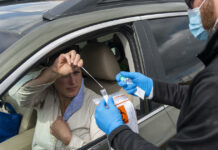Most of the 48 I.C.U. patients studied had pre-existing medical conditions, including two who died. Eighteen of the children were put on ventilators.

As concern grows over the potential for children to become seriously ill from the coronavirus, a new study paints the most detailed picture yet of American children who were treated in intensive care units throughout the United States as the pandemic was taking hold in the country.
None of the children in the study, published Monday in the journal JAMA Pediatrics, were stricken by the new mysterious inflammatory syndrome linked to the coronavirus that can cause life-threatening cardiac issues in children. They suffered from the virus’s primary line of attack: the severe respiratory problems that have afflicted tens of thousands of American adults.
The study looked at 48 cases from 14 hospitals, infants up to age 21, during late March and early April. Two of the children died. Eighteen were placed on ventilators and two of them remain on the breathing machines more than a month later, said Dr. Lara S. Shekerdemian, chief of critical care at Texas Children’s Hospital, and an author of the study.
Over all, the study both reinforces the evidence that only a small percentage of children will be severely affected by the virus and confirms that some can become devastatingly ill.
“You can read this either like a half-empty glass or a half-full glass,” said Dr. Daniele De Luca, the president-elect of the European Society for Pediatric and Neonatal Intensive Care, who was not involved in the study. “At the end of the day, we have to realize that this disease can actually be serious in children. It’s not like in the beginning when some people said, OK, this is never going to happen.”
The vast majority of the patients — 40 children, including the two who died — had pre-existing medical conditions. Nearly half of those patients had complex developmental disorders like cerebral palsy or lifelong technology-dependent treatments like tracheostomies or feeding tubes, children “who have trouble walking, talking, eating, breathing,” Dr. Shekerdemian said. Other pre-existing health issues included cancer and suppressed immune systems from organ transplants or immunological conditions.
Perhaps because it was so early in the pandemic, none of the children in the study displayed the newly identified pediatric multisystem inflammatory syndrome, which experts believe may be a latent condition that develops weeks after the initial coronavirus infection and assaults a child’s circulatory system with inflammation rather than directly attacking the lungs. Over the weekend, Gov. Andrew M. Cuomo of New York reported that three children in the state have died of that illness, and last week the journal Lancet reported a death in England.
The new study also suggests that, at least at this point in the pandemic, “nobody knows what the appropriate treatment is for these very sick children,” said Dr. Nigel Curtis, a professor of pediatric infectious diseases at the University of Melbourne, who was not involved in the research.
Hospitals used many methods of breathing support, as well as unproven medications like hydroxychloroquine, remdesivir and tociluzimab to treat the children. Other approaches included inhaled nitric oxide and blood plasma.
“They get a variety of different treatments in a very nonsystematic way because, of course, quite understandably, these intensive care doctors are going to do their best by these children and so they’re going to try different potential therapies,” said Dr. Curtis, who is also head of infectious diseases at the Royal Children’s Hospital Melbourne.
The study was conducted by members of an international collaborative of more than 300 pediatric intensive care and infectious disease specialists formed to study coronavirus in children and make recommendations.
Forty-six hospitals agreed to participate in the study, which included patients with confirmed coronavirus infections who were admitted to pediatric I.C.U.s in North America between March 14 and April 3, said Dr. Shekerdemian, who is also vice chair of pediatrics at Baylor College of Medicine. But only 16 of them had cases during that span, and only 14 reported data in time for publication, she said.
The 14 hospitals were all in the United States, and reflected the trajectory of the early pandemic, concentrated on the East Coast, with scattered cases in Texas and elsewhere. Young people up to age 21 were included, but all but three patients were 18 or younger, Dr. Shekerdemian said.
Given the small number of cases, it’s hard to know how representative the results are. For example, while studies on children in China and an early report by the Centers for Disease Control and Prevention suggested that infants and preschool-aged children were at highest risk, fewer than a third of the pediatric I.C.U. patients in the new study were that young. The two children who died were 12 and 17.
Dr. De Luca, who is chief of the division of pediatrics and neonatal critical care at Paris Saclay University Hospitals, said it made sense that older children with developmental disorders and other complex long-term problems would be more vulnerable than infants or toddlers to a virus like Covid-19.
“As they get older, they have lower immunity, they don’t move much, and their weakening muscles affect their respiratory condition,” he said.
Fourteen of the patients in the study had only mild or moderate coronavirus symptoms, and it’s possible that because of the previous fragile state of their health they were admitted to I.C.U.s as a precaution, experts said. Another was asymptomatic but was already in the I.C.U. for other reasons.
Still, 33 young people became severely or critically ill. And of the 18 who required ventilators, six needed additional respiratory interventions, including one child who needed a last-resort heart-lung bypass machine. Thirty patients experienced lung failure, and at least 11 also had failure of one or more other organs, such as the heart, kidneys or liver, Dr. Shekerdemian said. Two had neurological symptoms, primarily seizures.
The children’s cases were followed through April 10. At that point, 15 remained hospitalized, but most were no longer severely or critically ill, the study said. Four were on ventilators then, one of whom was also on the heart-lung bypass machine. Those four remain hospitalized now, with two still on ventilators, Dr. Shekerdemian said.
Scientists are also studying why most children seem less affected than adults, a question that could help them learn more about how the virus works in general. Theories include that cells lining the blood vessels and heart change as we age or that children’s lung cells express lower levels of proteins that help the virus enter the cells and replicate.
And doctors emphasize the need for standardized treatment approaches for children. “It’s critical that we try all these therapies in a systematic way,” Dr. Curtis said. “Clinicians worry that because there are small numbers of children that they’ll be left out of clinical trials, but it’s important that children are included.”







